October 2007 Cub Scout Roundtable Issue |
Volume 14, Issue
3
November 2007 Theme |
Theme:
Indian Nations
Webelos:
Craftsman & Readyman
Tiger Cub
Requirement 5 |
PACK AND DEN ACTIVITIES
Advancement Ideas:
www.cubroundtable.com
Tigers
– Ach
2F, 1G,
Elect. 7, 10, 14, 33, 47
Wolf-
Ach 11A,11C
Elect. 1D, 10B, 10E, 10F, 11C
Bear
– Ach 3B,
15C, 16B, 17D
Elect. 9B, 24A, 24B, 24C
Advancement Ideas
Alice, Golden Empire Council
Boys at all rank levels could work
on the Communication Belt Loop. Native Americans had many ways to
communicate – explore storytelling, music, codes and sign language as ways to
communicate. The Leave No Trace Award is another way to honor Native
American tradition to “walk lightly on the land.”
Tiger Cub
Achievements:
ü
Ach. #1G
– visit a museum to learn
about Native Americans in your area, or invite a Native American to visit your
den or pack; Ach. #2F – Use a map to see where Native Americans live and lived
in your area; Ach. #4F – practice listening to others and take turns talking;
complete Respect Character Connection; Ach. #5D- leaf rubbings;
Tiger Cub
Electives:
ü
Elective #3
– try an American
Indian board game;
ü
Elec. #6
– Learn a simple American
Indian song;
ü
Elec. #7 –
make a drum or rattles to play along, as American Indians do;
ü
Elec. #10, #11 –
participate in a local food drive or give service in some way (See “Give a
Hundred” under Pack & Den Activities);
ü
Elec. #14
– read a book about Native
Americans;
ü
Elec. #17
– if you make a model of a
Native American house;
ü
Elec. #21
– make an animal puppet to
tell a Native American story;
ü
Elec. #33
– if you have a litter clean
up;
ü
Elec. #47
– re-use or re-cycle something
– show respect for the land as Native Americans did.
Wolf Achievements:
ü
Ach. #1
– be creative and do these
physical feats as if you were a Native American-“walk along the fallen log” for
1b, or “roll under a bush”- 1c, etc;
ü
Ach. #7 a, d –
Respect, care for the planet;
ü
Ach. #10c
– visit a museum to learn
about Native Americans;
Wolf
Electives:
ü
Elec. #1d
– Native American sign
language;
ü
Elec. #2
– if you put on a skit about
Native Americans, or tell a story from their culture;
ü
Elec. #4f
– choose a Native American
game; Elec. #6b – choose a book about Native Americans;
ü
Elec. #10
– American Indian Lore;
ü
Elec. #11e
– choose an American Indian
grace – one example, pg. 10, Program Helps;
ü
Elec. #11f –
learn and sing a Native American song;
ü
Elec #22a
– Learn to say hello in Indian
sign language or try to pronounce an Indian word for hello
Bear
Achievements:
ü
Ach. #3a
– if you choose to write about
Native Americans and their impact on making America special;
ü
Ach. #3d
– if you visit a local museum
or living history site to learn about Native Americans in your area;
ü
Ach. #6a, 6g –
show the same respect for the land that the Indians did by clearing away litter
and preventing it through recycling;
ü
Ach. #8e –
see if there is Native American history in your area and learn about it;
ü
#8f –
start your own history – you could make a “buffalo skin” history or important
events in your life;
ü
#8g –
Respect – a quality Native Americans admired;
ü
Ach. #10a
– visit a park or museum where
you can learn about Native Americans;
ü
Ach. #15b, c
– play Native American
games;
ü
Ach. #16
– some of these skill games
were done in Native American tribal groups;
ü
Ach. 17d –
research and share information about Indian customs;
ü
Ach. #19 –
learn knife safety and carve a totem, Inuit game piece, animal fetish or animal
sacred to Native Americans out of Ivory Soap;
Bear
Electives:
ü
Elec. #8a
– make a rattle or Indian drum
to use in playing a game, accompanying a Native American song, or as part of a
skit;
ü
Elec. #9a
– make a Native American craft
such as beading, pottery, sand painting;
ü
#9b
– visit a museum and note the art
made by Native Americans;
ü
Elec. #10b –
make an animal mask to use in telling a Native American story;
ü
Elec. #22b
– mount scout badges on a
“buffalo or animal skin” as shown on pg.269 to display at Pack Meeting;
ü
Elec. #24
– American Indian Life
Webelos Activity Pins:
Assigned activity badges are
Craftsman (try making some of the Native American tools, clothing and
objects out of leather, clay and rope) and Readyman. Also, under
Athlete, the Dual Contests are very similar to Native American contests.
Leave No Trace and Conservation Projects under Outdoorsman also fit the
theme.
Ideas for Pack
Activities:
Baltimore Area Council
ü
Make a feathered
headband as a gathering activity (use turkey feathers)
ü
March in a Veteran’s
Day Parade
ü
Collect canned food
for local food bank
ü
Invite a Veteran to
speak at your Pack meeting
ü
Have a Thanksgiving
feast outdoors like the Pilgrims
ü
Invite an Order of
the Arrow group to demonstrate an American Indian dance
Ideas for Den
Activities:
Baltimore Area Council
ü
Learn about American
Indian tribes that lived near you
ü
Make Thanksgiving
Decorations
ü
Make cards for a
local Nursing Home
ü
Invite a local
politician to talk to your Den
ü
Invite a veteran to
visit your Den
Alice, Golden Empire Council
·
Have a “Pow-Wow” or
gathering of tribes for your Pack Meeting. Perhaps each boy, family or den
could choose a particular tribe – learn about their customs and crafts and make
a display of what you have learned; make or wear a costume that represents that
tribal group; perhaps they could make and share a food, such as Indian Fry
Bread, for the refreshments.
·
Have each den or
family learn a traditional dance from a tribe of their choosing – go to
http://www.apples4theteacher.com and scroll down to games or dances – you
could even learn the music that goes with the performance (they’ve included
actual scores of the music)
·
Have a display of
crafts made by the boys during the month – based on traditional crafts such as
beading, pottery, basketry, sand painting, kachina dolls or leatherwork
·
Encourage each boy
or family to create their own Native American prayer – Indian prayers often
referred to nature in some way. And while they seem poetic, they didn’t
actually rhyme, so they are little easier for boys to create. Here’s an example
from the Tewa tribe of New Mexico:
“Weave us clothing of great
brightness,
That we may walk where birds sing
and grass grows green,
Oh, our mother the earth – Oh, our
father the sky.”
First,
have the boys decide on which thing in nature they want to write their poem
about.
Then
have them list qualities – colors,
size, texture, purpose or how they affect humans –
Now
they can just tell you what they notice about their part of the natural world –
a parent or leader can help write down what they say – or boys can use the
computer to write phrases describing what they see and feel.
·
Let each boy choose
a name for himself, as many American Indians do even today. Have them think
about their physical characteristics (hair color, etc.), a book or character
that they admire, a particular interest (such as “He who collects Rocks”) or a
skill that he has, such as art or music (“Tames Wild Horses” is a name given to
a Hopi boy who won several blue ribbons for his skill in riding and training
horses)
·
Have a display of
Native American homes – each boy or den could choose a particular kind of
American Indian home to make a model of – see the “Tribe by Tribe” list in this
packet for ideas
·
Check with your
local Order of the Arrow – they often have a tipi made of canvas, with lodge
poles and traditional construction. They might be willing to put it up – sitting
inside a tipi is unlike any other kind of dwelling – they look small from the
outside, but once the boys are seated around the center, they will have a very
special feeling – and find that the space is much more than it looks.
·
The Order of the
Arrow also often has dance teams – invite them to perform for your pack meeting.
·
Check with local
colleges and universities to see if they have a club for American Indians or an
International Students Club – they might have a speaker who can come and share
insights about Tribal customs. Another great resource is state and national
parks – if there is a history of American Indian Nations in your area, they
often have rangers or volunteers, sometimes American Indians themselves, who
lead various American Indian activities. Almost every part of the United States
was inhabited or used by American Indians – so learn about the groups that lived
and still live in your area!
·
Tell the story of
Squanto – and share other regional stories of how American Indians and local
settlers interacted. The first pilgrims would not have survived without the
help of Squanto – find out how he was able to speak to them in English – see
the story in Baloo.
·
Since storytelling
was an important part of American Indian customs, check out the Apples 4 the
Teacher website for a list of many stories. Each den could choose a story to
act out as part of the Pack Meeting.
·
In honor of the
Native American tradition of caring for the land, have a den or pack clean-up;
pick up litter in a nearby park, at your chartered organization site, etc.
·
In honor of the one
hundred years of Scouting we celebrate this year, make an individual, den or
pack challenge to “Give a Hundred!” You could do 100 hours of service
throughout the year, work on 100 service projects, give 100 pencils, cans of
food – choose a project that appeals to you. Within your den, ten boys working
together giving 10 hours of service each equals 100! Let the community see
Scouting in Action!
Indian Talking Stick
National Capital Area Council
You need:
Stick (measuring 1/2" x 24")
Yarn
Fur Scrap
2 Jingle Bells
12" Suede Cord
4 Pony Beads
2 Feathers
Tacky Glue
Scissors
Instructions:
ü
Cut a piece of fur
1" x 2".
ü
Wrap it around the
end of the stick.
ü
Use tacky glue to
secure it.
ü
Spread a little glue
at the end near fur.
ü
Wrap yarn tightly
around stick adding more glue as needed.
ü
Cover about 5" of
the stick changing the color if desired.
ü
Tie suede lace near
the bottom of the yarn wrap.
ü
Thread the lace
through the bells and knot again.
ü
String 2 pony beads
onto each end.
ü
Tie off and trim.
ü
Slip feather ends up
through beads with a little glue to secure.
Talking Stick Legend
National Capital Area Council
Whoever holds
the talking stick, has within his hands the sacred power of words. Only he can
speak while he holds the stick; the others must remain silent. The feather tied
to the talking stick gives him the courage and wisdom to speak truthfully and
wisely. The rabbit fur on the end of the stick reminds him that his words must
come from his heart and that they must be soft and warm. The speaker should not
forget that he carries within himself a sacred spark of the Great Spirit, and
therefore he is also sacred. If he feels he cannot honor the talking stick with
his words, he should refrain from speaking so he will not dishonor himself.
When he is again in control of his words, the stick will be returned to him.
Drum
Baltimore Area Council
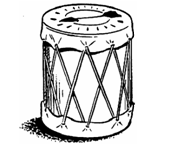
ü
Cut both ends from
the tin can.
ü
Cut two circles of
rawhide or canvas about 4 inches larger in diameter than the can. This will
leave a 2-inch border for lacing.
ü
Punch holes about ¾
inch from edge all around the rawhide circles.
ü
Lace top and bottom
to drum with leather or plastic lacing. Stretch tight.
ü
Paint drum, with
Indian symbols.
ü
Make a drumstick by
covering a wad of cotton with a piece of rawhide and binding it to a stick or
dowel with a sturdy string.
Indian Arm Bands
Baltimore Area Council

Equipment:
Two 6 ounce tuna or cat food cans
Brass paper fasteners
Turquoise enamel
Directions:
ü
Remove top and
bottom of cans.
ü
Cut on the seam.
ü
Fold over the ends
and hammer flat.
ü
File off any rough
edges.
ü
Decorate with
turquoise stones (heads of brass paper fasteners which have been dipped in
enamel
Indian Bracelet
Baltimore Area Council
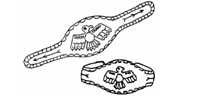
Equipment:
Foil pie pan;
knitting needle,
blunt pencil or dry ball point
pen;
sandpaper
Directions:
ü
Cut bracelet shape
from pie pan with scissors.
ü
Use a knitting
needle or blunt point of a pencil to trace over design, bearing down so it will
be transferred to foil.
ü
File rough edges
with sandpaper.
ü
Add a turquoise
modeling dough stone in center of bracelet, if desired.
ü
Bend bracelet to fit
wrist.
Dream Catcher
Baltimore Area Council
Dreams are
messages from sacred spirits according to legend. The Dream Catcher represents
the web of life and its job is to sift the dreams of those sleeping nearby. The
hole in the center of the web allows the good dreams through, while the bad
dreams are caught in the web and disappear in the morning sun. Dream Catchers
are believed to bless the sleeping one with pleasant dreams, good luck and
harmony throughout their lives.

Materials
Needed:
One 3-inch ring,
one 6-foot piece of suede lacing,
2 yards of artificial sinew (or
waxed linen or dental floss),
1 piece of acrylic wool
(optional),
6 feathers (optional adornment),
1 charm (optional adornment),
4 beads (optional adornment),
scissors, ruler, string,
clothespin, Glue (hot glue gun not recommended)
Instructions:
ü
Glue one end of the
suede lacing to the ring.
ü
Use a clothespin to
hold it in place until dry.
ü
Wrap the lacing
around the ring to the starting point, being careful not twist the lacing.
ü
Cut off excess
lacing and glue the end to the ring, holding it in place with a clothespin until
dry.
ü
To make the web, tie
one end of the sinew to the ring using a square knot.
ü
Next, tie
approximately 9 half-hitch knots around the ring, spacing them about 1-inch
apart.
ü
To begin the next
row of the web, begin tying half-hitches in the middle of the sinew already
attached to the ring.
ü
Continue tying
half-hitches in the same way until the opening in the center is the desired
size.
ü
To end the web, tie
a square knot in the sinew, then cut off the excess.
ü
Use extra suede
lacing to make a loop to hang the dream catcher.
ü
Decorate with
acrylic wool, feathers, charm, and beads as desired.
Teepee Piggy Bank
Baltimore Area Council

Materials:
Heavy cardboard,
1 gal or larger bleach bottle,
paint, glue
Directions:
ü
Cut top half of
bleach bottle off and discard bottom.
ü
Cut circle of
cardboard to fit bottom and glue on.
ü
Paint as a teepee.
ü
Remove lid and clue
three sticks in the hole.
ü
Cut a slot in the
back for money.
ü
The handle on bottle
is a handle for the bank.
ü
Decorate.
Clip Board Neckerchief Slide
Norm
Here’s a slide
from Norm that makes you really look prepared. Norm says he always gets
comments when he wears this one. CD
Materials
Hunt #1 clip or
equivalent
2” wide by 3” high
1/8” thick piece of Masonite
Leather strap for
loop
2” by 3” Post-It Pad
Drill
Directions
ü
Cut
Masonite to 2” by 3” and drill holes as shown
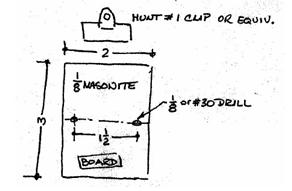
ü
Cut
leather strap as shown

ü
Attache strap to board with 3/8” pop rivets with back up washers or 1/8” by ½”
split rivets.
ü
Cut
Post-It Note pad to 2” by 3”
ü
Clip
onto front of boards
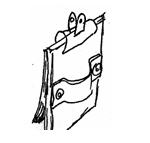
Tom-Tom Slide
Heart of America Council

Materials:
(Note: Chamois is a
light weight leather that can be found in the car washing supplies at any store)
• Heavy cardboard
ring 5/8’ high, 2 1/4’ diameter
• Piece of chamois
• Glue
• Paints
Directions:
ü
Cut
chamois large enough to cover cardboard ring, leaving ends long enough to tie in
back.
ü
Put a
bead of glue around one end of cardboard ring and press into center of chamois.
ü
Pull
ends around and tie in back, trimming ends.
ü
Glue
edges of chamois down around outside of cardboard ring.
ü
Paint
Indian designs on front. Or wood burn designs in.
Indian Walnut tie Slide
Heart of America Council
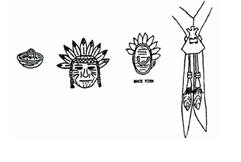
Supplies
Walnut shell half,
colored paper,
plaster of Paris,
café curtain ring,
permanent marker,
dark color, yarn.
Procedure:
Fill the shell with
plaster of Paris and set the curtain ring.
Let dry.
Attach yarn for
hair.
Cut out paper
feathers.
Glue them from
behind.
Draw a face with
permanent marker
Tepee
Heart of America Council
Many Native American
tribes made tepees (tepee is sometimes spelled tipi or teepee) from long tree
limbs and animal hides. You can make a wonderful model tepee using a brown paper
grocery bag and twigs. This is a simple, inexpensive craft and one that looks
quite good!
Supplies needed:
4 straight twigs
(about a foot long each)
Yarn, twine, or a
rubber band
A large, brown paper
grocery bag
Scissors
A pencil
Crayons, tempera
paint, or markers
Tape
Directions:
ü
Bind
the twigs together toward the top using yarn, string, or a rubber band.
ü
Leave
about 3 inches of twig at one side of the string. Do not bind the twigs too
tightly.
ü
Gently
adjust the twigs so that they form a tepee shape.
ü
Holding the tepee above a piece of scrap paper, trace the outline of one side of
the tepee. This will be your template for making the tepee.
ü
Cut
out your triangular template.
ü
Open
up a large paper bag along its seams.
ü
Lay
your triangle template on the opened bag and trace its outline.
ü
Trace
the triangle 3 more times with the long edges touching.
ü
Cut
out this large polygon along the outside edge.
ü
Cut a
door on one edge.
ü
Decorate the tepee using crayons or markers.
ü
Fold
the paper along each of the pencil lines.
ü
Then
form the paper into a tepee shape and tape the edges together.
ü
Snip
off the top of the tepee (the twigs will go through this hole).
ü
Put
the twigs into the tepee.
ü
Tape
the twigs into place - each twig is taped along a fold line.
ü
You
now have a wonderful tepee!
Pocket Dream Catcher
Heart of America Council
Materials:
Tacky glue
1 1/4 ” key ring (or
plastic ring from soda bottle)
Assorted pony beads
Embroidery floss or
yarn
Safety pin
Scissors
Directions:
Cut a 6” piece of
yarn or floss.
Slip one end in the
split of the ring to hold it in place.
Wrap the lacing
around the metal ring.
Glue the end to the
lacing where they meet.
Roll a 1 yard piece
of yarn or floss loosely into a ball.
Knot one end of the
yarn around the metal ring then seal the knot with glue.
Tie approximately
four half hitches around the ring.
Pinch each completed
knot as you begin the next.
Add a half hitch
right next to the knot where you began.
Then begin tying
half hitches in the middle pf the cord you have already added.
Double knot the cord
in the center of the webbing
Then seal knot with
glue.
Cut off excess cord.
Cut a 4” length of
yarn.
Knot ends together
and insert one end of loop through metal ring at the top.
Draw knot through
loop and pull tight.
Add a pin.
Cut three 4” pieces
of yarn.
Fold each piece in
half and tie to ring bottom using a half hitch.
Lace pony bead
through both ends and knot in place.
Cut off excess.
Materials found in Baloo's Bugle may be used by Scouters for Scouting activities provided that Baloo's Bugle and the original contributors are cited as the source of the material. |
|





